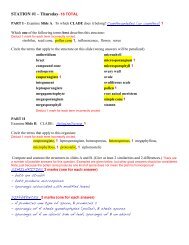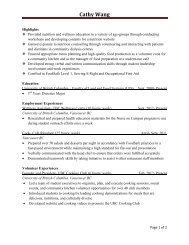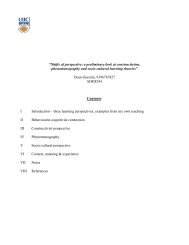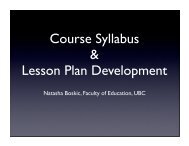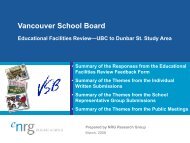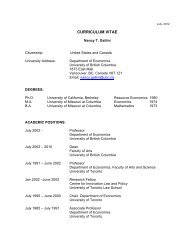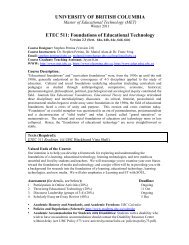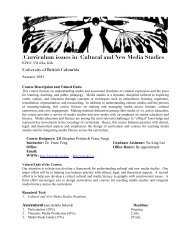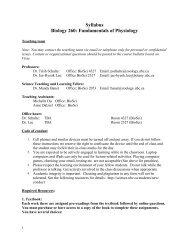Learning Management System Proposal - UBC Blogs
Learning Management System Proposal - UBC Blogs
Learning Management System Proposal - UBC Blogs
Create successful ePaper yourself
Turn your PDF publications into a flip-book with our unique Google optimized e-Paper software.
To: School District 83 Technology Committee February 5, 2012<br />
From: Mike Rybachuk<br />
Re: <strong>Learning</strong> <strong>Management</strong> <strong>System</strong> <strong>Proposal</strong><br />
---------------------------------------------------------------------------------------------------------------------------------------<br />
Introduction<br />
Currently School District 83 is under contract with the First Class <strong>Management</strong> <strong>System</strong>. First<br />
Class is used by all district personnel for email communication, as a district calendar of events,<br />
including in-service and professional development opportunities, as well as a main communication<br />
tool with parents in the form of Parent Connect. First Class houses the district directory, student<br />
grades, and is the host for SD 83 websites. First Class is very much an administrative system.<br />
In this proposal I will make a case for the district to adopt a new <strong>Learning</strong> <strong>Management</strong> <strong>System</strong><br />
LMS, Moodle. I intend to show that Moodle offers a significant array of learning tools to support<br />
teachers and students as we embrace the Province of British Columbia’s move towards personal<br />
learning, both inside and outside of the classroom.<br />
What is Moodle?<br />
Moodle (Modular Object-Oriented Dynamic <strong>Learning</strong> Environment; http://moodle.org) is an<br />
Open Source learning platform is capable of being run on many operating systems, including<br />
Windows, currently in use in SD 83. As Open Source software, it’s free to download, change, share,<br />
improve, and customize to whatever you want it to be (Walsh, 2010).<br />
As a LMS, Moodle offers teachers and administrators a web based template where content,<br />
instruction, assessment, and communication can easily be uploaded, shared and customized.<br />
Moodle promotes social constructivist pedagogy of collaboration, active thinking, and critical reflection<br />
(Martinez and Jagannathan, 2008).<br />
Why Moodle in School District 83?<br />
District 83 teachers continue to strive to offer the best educational opportunities for their<br />
students. Limited resources, budget restraints, and declining enrolment are but some of the factors<br />
that challenge all aspects of our educational system. The role of the teacher as the “Sage on Stage”<br />
is not longer an effective model for today’s learners. Students are looking for more varied educational<br />
opportunities, chances to use and interact with the technology of business and industry. They need a<br />
variety of learning opportunities to match their distinct learning styles and abilities. Economic factors,<br />
illness, along with elite athletic and fine arts opportunities are increasingly keeping students out of<br />
school, severely hampering academic achievement in the traditional classroom. This in turn places<br />
tremendous pressure on teachers as they look for new tools to help meet the learning needs of their<br />
students. I propose that Moodle is one such tool.
As a web based system, Moodle offers many tools that teachers need. It can be used totally<br />
online, or to augment a face to face learning environment. Using course templates, teachers can<br />
easily upload course content in a variety of formats. Resource pages allow teachers to provide<br />
structure in the form of headings and units, links to existing web pages, podcasts, video, or other<br />
online materials. Review for students requiring additional scaffolding of concepts, or extension<br />
materials ensure all students get the support and challenge they require. Activity pages allow teacher<br />
to include assignments, chat forums, lessons, quizzes, surveys, or any number of similar learning<br />
situations. Moodle allows for easy navigation throughout any course site, allowing students flexibility,<br />
direction and support. Teachers can easily move from teacher to student role, allowing ease in both<br />
course construction and editing. It has been designed to support modern pedagogies based on<br />
social constructivist theory, (Itmazi, Gea, Paderewski and Gutierrez, 2005)... [and] in general it is<br />
easy to use, install, and maintain.<br />
This ease of use and flexibility of design is what teachers need. Time is a key factor when<br />
introducing any new technology and Moodle is relatively easy to jump into. This ease of<br />
implementation is another factor why Moodle is a good fit for our district. As teachers begin to use<br />
the LMS, they are easily able to share knowledge because of Moodle’s common delivery platform.<br />
This involvement in a knowledge community fosters confidence and reduces the time teachers<br />
require to implement the new technology. This local support model is what drew users to Moodle in<br />
the first place (Delinger and Boora, 2010).<br />
Students will have far less issues due to their already ubiquitous use of technology in and out<br />
of the classroom. Moodle access from home, at school, or via any web browsing tool (smart phone)<br />
allows students to take their learning with them. Discussion forums email and other collaborative<br />
tools allow students to stay in touch with learning and each other. Parents have increased access to<br />
course content, feedback and grades, something lacking in the traditional classroom setting.<br />
Moodle must work as it is gaining in popularity. From 2006 to 2008 registered Moodle sites<br />
more than doubled worldwide, while the number of users nearly tripled (Martinez and Jagannathan,<br />
2008). Croy and Smelser (2009) report that when asked to indicate overall preference, 81% of the<br />
faculty at the University of Northern Carolina preferred Moodle. These numbers clearly indicate that<br />
Moodle use continues to grow. Our students are likely to use Moodle once they leave our school<br />
system and being familiar with its many affordances prepares them for success.<br />
Cost<br />
As an Open Source system, Moodle is cost effective on a number of levels. Unlike other<br />
proprietary software the cost of licensing is almost nothing, while changes, modifications and<br />
improvements occur without pay. With its continued growth and popularity, the array of free online<br />
help, in the form of websites, wiki’s and videos, continues to grow. Many say that the cost savings is<br />
not the key Moodle advantage, but it is rather access to various innovative tools that interface with the<br />
Moodle platforms (Martinez and Jagannathan, 2008).
Real budget constraints will continue to be a factor in all aspects of education, especially<br />
technology. The reduction of attainment and operations costs attached to Moodle will allow the<br />
district some freedom to offer additional in service to teachers using Moodle. Timely in service is<br />
essential for technology implementation. District professional development days, small group<br />
sessions and school based collaboration offer just in time learning for teachers using Moodle. Not<br />
only is this type of teacher learning cost effective, it promotes collegiality and offers a solid knowledge<br />
base for teachers wanting to use Moodle at a later date.<br />
Conclusion<br />
Teachers in School District 83 strive to meet the unique and diverse educational needs of their<br />
students. Technology that can meet the pedagogical needs of the learner yet fit into the varied<br />
toolboxes of district teachers would be a valuable addition to our educational system. I suggest that<br />
the introduction of Moodle, an Open Source LMS is a tool that offers tremendous opportunities for all<br />
members of our educational community. Its cost effectiveness, ease of use, and continued growth<br />
offer a good fit for now, and the future.<br />
References<br />
Croy, M., & Smelser, R., (2009). <strong>Learning</strong> <strong>Management</strong> <strong>System</strong> Evaluation. Report to the Prevost of the<br />
University of Northern Carolina, May 15<br />
Delinger, S., & Boora, R., (2010). <strong>Learning</strong> <strong>Management</strong> <strong>System</strong>s Evaluation for the University of Alberta<br />
Itmazi, J., Gea, M., Paderewski, P., & Gutierrez, F., (2005). A Comparison and Evaluation of Open Source<br />
<strong>Learning</strong> <strong>Management</strong> <strong>System</strong>s. IADIS International Conference-Applied Computing. Algarve,<br />
Portugal. Feb 22-25<br />
Martinez, M., & Jagannathan, S., (2008). Moodle: A Low-Cost Solution for Successful e-<strong>Learning</strong>. <strong>Learning</strong><br />
Solutions Magazine. November 10.<br />
Walsh K., 2010. Moodle 2.0 versus Blackboard 9.1 – a Brief Comparison. Emerging EdTech. November 7.




